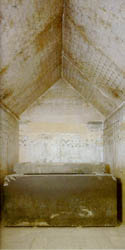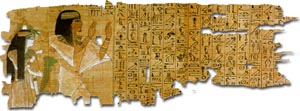The Funerary Texts
Pyramid Texts

The Pyramid Texts are the earliest Egyptian funerary texts. They consist of approximately eight hundred spells or "utterances" which were carved on the walls and burial chambers of nine pyramids of the late Old Kingdom. The earliest surviving Pyramid Texts are found on the Fifth Dynasty pyramid of King Unas (image at left is of his burial chamber) at Saqqara. The first Pyramid Texts to be discovered were found in the pyramid of King Pepy II. None of the pyramids contains all of the utterances. The utterances evidently were not written in any particular order. The pyramid with the most belonged to King Pepy II. It held 675.
The Pyramid Texts were first discovered in 1880 by Gaston Maspero. Two years later, Maspero began the first translation of the texts. At first, scholars believed that the texts may have pre-dated the pyramids themselves by hundreds or even, thousands, of years. Now, many scholars believe that the texts are contempory to the pyramids.
In the Old Kingdom, only the pharaoh had the ability to live on beyond death. As a living god on earth, he was the connection between the divine and the mortal. The pharaoh's duty on earth was to uphold Ma'at, the principle of order and truth. At death, the Pyramid Texts stated that the pharaoh was to become the sun or the new Osiris. However, the journey of this transformation was perilous. The Pyramid Texts were a collection of spells, prayers, descriptions and instructions designed to allow the king a safe journey to the Afterlife.
The texts repeatedly refer to the cult of the sun-god. This implies that they were originally written by the priests of Heliopolis. Several of the spells are written in an archaic dialect or refer to features of the funerary cult that were no longer current at the time the pyramids were built. This indicates that at least some of the Pyramid Texts can be dated to Pre-Dynastic times.
The texts may provide clues to the thinking behind the development of the pyramid itself. The ultimate destination of the pharaoh after death was the sky. The pyramid, in its original stepped form, provided him with a staircase to the sky. In its later true pyramid form, the pyramid symbolized the sun's rays, which were another means by which the king could ascend to the heavens.
Coffin Texts
During the Old Kingdom, the afterlife was only available to the king. However, after the Old Kingdom collapsed, the people became more self-reliant. With this new development came a process by which the common people received the promise of the afterlife. Egyptologists refer to this evolution of thought as the "democratization of the afterlife."
Now that the common people had a chance at life after death, they meant to cash in on it. Therefore, they had spells carved on their coffins or sarcophagi that contained instructions and protections for living on after their death. These spells were descended from the Pyramid Texts and formed the basis of the Book of the Dead. Over 1,000 spells have been recorded. Collectively, these spells are known as the "Coffins Texts."
Like the earlier Pyramid Texts, the Coffin Texts indicate that there was more than one possible destination for the deceased. They might join the sun-god Re in the sky, or pass into the underworld of Osiris. The earlier texts subscribe to the first version, while the latter were more likely to indicate the second. This changing thought pattern led into the funerary beliefs of the New Kingdom, which Osiris dominated.
Book of the Dead (Book of Going Forth by Day)

The Book of the Dead is a New Kingdom collection of texts composed primarily from earlier funerary works such as the Pyramid and Coffin Texts. It was usually written on papyrus, however many individual chapters of the book have been found on tomb walls, scarabs, statuettes and on at least one royal mortuary temple (Rameses III).
Manuscripts of the Book of the Dead were customized with the name of each deceased person prefixed by "Osiris" (i.e. Osiris-Rameses). The books also included the deceased person's job title and family relations. Some books were written ahead of time with the spot for the deceased's name left blank. The name was filled in later when the book was purchased.
The cost of the books probably varied widely, given the range of quality found in still existing books. The book was made affordable for almost all Egyptians when abbreviated versions became available the Late Period.
The Book of the Dead is renowned in large part due to the vignettes, or small paintings, that accompany the text. Quite famous is the vignette of the "Judgement of the Dead" from Chapter 125. Some of the vignettes originally appeared in the Coffin Texts. The number of vignettes in a copy did not follow any standard. Some versions had none, while others had a drawing for almost every chapter.
It seems that in at least some cases, the layout of the book and the painting of the vignettes was done prior to the filling in of the writings. This resulted in the mislocation of the vignettes. Also, in some cases the text suffered omissions or abbreviations as the scribe ran out of space! The Book of the Dead was written in cursive hieroglyphics. The book was divided by "rubrics", or headings written in red ink. These divisions in the book are called "chapters" by modern Egyptologists.
The modern name of the Book of the Dead derives from the Arabic title, and simply refers to the fact that it usually accompanied mummies. The ancient name, "The Beginning of the Spells for Going Forth by Day" is found at the beginning of Chapter 1 (and Chapter 17). However, there is some debate concerning whether this title describes all of the book, or was meant only for that chapter.
A few chapters of the book were used widely outside of the papyrus. Chapter 30, the heart spell, was carved on the amulets placed in a mummy's body prior to wrapping it with linen. Also, chapter 6 was carved onto the shawabtis, small mummiform statuettes placed in tombs. The chapter was meant to allow the shawabtis to spring to life and do any work needed by the deceased.
Digg This!
![]() Del.icio.us
Del.icio.us
![]() Stumble Upon
Stumble Upon
